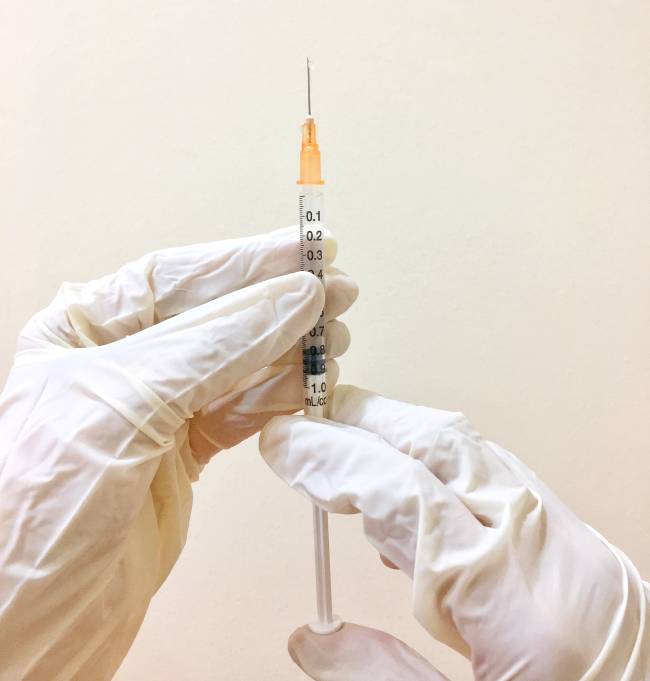Dog allergies– it’s a muddled topic for a pet parent, one you wade into with so. so. many questions… Food vs. inhalant? There’s contact too… Okay. What do allergy symptoms actually look like in dogs, then?
Though, perhaps not as many questions as your search leaves you with – how much scratching is too much then? Was his belly always a little pinkish?
So, what exactly do you need to know about allergies? We’ll cover the what, why, how, and more for you– including what you can do to offer your dog relief.

On The Agenda
What Are Allergies
First and foremost, let’s get our vocabulary straight.
When I say allergies, you say hyper-reactive immune response. Really rolls off the tongue, doesn’t it.
In the simplest terms, allergies are a hyper-reaction– one that occurs when our bodies and our pet’s bodies hyper or over-react to allergens.
This response creates heat and inflammation and causes the uncomfortable symptoms that plague your pup.
Who Gets Allergies
Any dog can develop allergies. That’s because allergies are simply a combination of variables coming together to create this perfect storm.

There are breeds of dogs and lines of dogs that have a genetic propensity for allergies as well. Golden Retrievers, for instance, tend to develop gooier and greasiness to their coats and experience allergies more than other dogs do. But that simply means that these pet parents should be more aware that it’s a possibility.
The bottom line, though, every pet parent should keep in mind that any dog, theirs included, could experience allergies.
When Do Allergies Start in Dogs
Allergies can develop as early as 8 months to a year, but you seldom see allergies in puppies or really young dogs. That’s because hypersensitive reactions happen when a dog is repeatedly exposed to the same allergen.
A reaction isn’t just a random occurrence. Older pets have more exposure, so they’re more likely to experience that type of pollen. They’ve had 5 or 8 seasons of ragweed under their proverbial belt.

So, the first time a reaction happens to that ragweed, for instance, the body responds with sneezing, redness, histamine release, but that’s the body’s normal sensitivity reaction.
When repeatedly exposed to that allergen, though, that sensitivity reaction becomes more exaggerated and extreme till we see it as the hypersensitivity reaction.
But there’s wide variability in that spectrum, too. From the time it happens to when we start to notice they’re miserable.
Why Do Allergies Happen
It may have been one allergen or a lot of smaller compounding ones. While the why is important and frankly interesting, the bottom line is when you’re asking what causes allergies, it isn’t really about the allergens.
It isn’t the allergen’s fault. It’s the body’s hypersensitive reaction, and that’s what needs to be addressed to give your dog relief long-term.
What Do Allergies Look Like
Allergies don’t look quite the same as human allergies. There are a wide variety of symptoms, which is often why we’re left googling, “Is X allergies?”
But symptoms actually help to categorize the allergy. In fact, the type of symptoms, i.e., where it is expressed in the body, can help determine the type of allergy and help your pet.
Symptoms expressed gastrointestinally or in the GI
- Chronic or intermittent vomiting
- Chronic or intermittent diarrhea
- Gurgly guts
- Irritable bowel
- Itchy rashes, hot spots, bald spots, and even recurrent ear infections in the worst cases
Symptoms expressed in the skin or outer surface
- The skin is hot and red to the touch because it’s inflamed.
- That inflammation tends to go to the head (think ears) and to the butt and the belly and armpits– areas where the skin is thinner.
- The coat has a gooey or greasy feel.
- The inflammation prompts unmanageable itchiness– the 24/7 variety.
- Panting & restlessness because they are just. so. itchyyy.
- Hives or a rash
- You might see weeping in the eyes, but it is different from a human. So, it would be a thicker discharge compared to the watery eye symptoms that we struggle through.

Types of Allergies
The use of the word allergy has become an umbrella term for hypersensitization, so it’s best to think about any allergic reaction as such when you dig into the types of allergies in dogs.
Allergy symptoms– where the heat and inflammation are expressed in the body– indicate the type of allergy, which are generally broken into three categories.
Food

Food allergies are a gradual progression. In the early stages, a dog can have a sensitivity, in which case you’ll see those GI issues mentioned above.
These GI symptoms can continue to get worse and worse and over long periods of time and can become a full-blown hypersensitivity reaction. So they aren’t just experiencing uncomfortable GI symptoms, but you’ll also see the skin issues– itching, redness, swelling
Common food allergies in dogs
There are very common ingredients in popular pet foods that are considered triggers or what we could call allergens. The list includes corn, wheat, rice, soy, eggs, milk, yeast, potato, and beets. Commonly used proteins like chicken are also allergenic.
Consider, though, that food sensitivities could also be triggered by the quality of ingredients in a pet food, feeding the same diet for years, and biologically inappropriate foods, including fillers, additives, and preservatives.

Inhalant
Inhalant or environmental allergies can be seasonal or year-round. The symptoms are typically skin-related, so think itching, itchy, itching with a side of itch, brought on by the extreme inflammatory response that creates heat, inflammation, and stress.
When are allergies the worst?
In many areas of the US, seasonal allergies begin in the spring when temperatures warm, and everything starts to come to life again. Plants, trees, and grasses start to pollinate, and that growing season can extend to mid to late fall when ragweed season is at its peak.
But dogs can still experience seasonal allergies, or inhalant allergies, in the winter, too. Say you have a wood-burning fireplace, and you burn cedar. Exposure to that year after year could develop into a hypersensitivity reaction to that allergen.

Contact
This type of allergy is also skin-related. It could happen after you wash them with a type of shampoo, for instance, or they roll around in hay, and hives or a rash develops.
Again, it’s not so much about the allergen – food vs. inhalant vs. contact– as it is the body’s inappropriate response to it– the hyper-reaction.

Why Do Allergies Get Worse
If you don’t focus on correcting the body’s hyper-reaction, the problem is only exacerbated.
Take inhalant allergies, for instance. In the first year, the allergen may be pollen, the second pollen & ragweed. By the fifth and sixth year, they’re allergic to ten different types of grass and carpets.
The allergy snowballs from seasonal to year-round and then into foods.
But it all points back to the underlying issue– the body’s hyper-reactive immune response.
Why Allergies Are So Common

No one knows for certain, but there are several common theories to consider. There may be some truth in all of them –
Over-vaccination
We want to provide our pets with every immunologic protection we can against diseases. The whole principle behind vaccines is providing a stimulus to make an antibody so that if they do encounter this infectious disease, they have a proper immune response and don’t die from it.
But there’s a difference between protection and over-vaccinating. Annual vaccinations hyperstimulate their immune system.
We, as humans, don’t get vaccines for measles, mumps, or DPT annually. We’re given them as children, and we’re vaccinated for life because vaccines never wear off.

Protocols for dogs and cats include not just a series of shots in their infancy but also adulthood though. So, how often do we need to vaccinate dogs and cats, and which ones are actually required should be on every pet parents’ radar.
There are core and non-core vaccines– ones that every dog and cat need, and others that may make sense for some animals and not others. A dog getting a rattlesnake bite vaccine when they live in NYC, for instance, doesn’t serve that animal.
To avoid over-vaccination, pet parents should also consider taking other steps like going to more vet appointments to space out the vaccines or opting for a titer test to make sure your dog really does need a vaccine before giving additional vaccines.
Pesticide, Herbicide, & Household Products

The average dog doesn’t wear shoes. So, dogs and their paws are exposed to anything, and everything found on grass and sidewalks or applied in our homes.
There are trace amounts of glyphosate, the active ingredient in Roundup, foods, soil, and water. And animals are reported to have fifty times the glyphosate levels that humans do in their bodies, which isn’t necessarily a surprise when you consider the many ways dogs are exposed– through groundwater, grass, and soil.
Household cleaning products like bleach, alcohol, ammonia– the ingredients that actually make a product effective make them toxic to us and our pets. Exposure to them– through their pads, skin, or licking, contributes to their toxin exposure overall.
Chemicals are put on and or in them every month to prevent fleas, ticks, & heartworm
Monthly applications introduce the body to toxins and put the liver under a lot of stress. These treatments protect your dog, so we’re not saying don’t utilize them. Just take stock to decide when and if it’s warranted– A dog living in the northeast (beautiful places, worst tick populations) needs preventative care, whereas a dog living in an apartment in the heart of NYC really doesn’t.
If and when these preventatives are necessary, give your dog Milk Thistle two days before and after a vaccine or flea/tick/heartworm treatment. It’s a hepatoprotective herb that reinforces the liver as a protectant and also as a detoxifier.

Dogs drink water from the same source every single day
Humans drink from multiple different sources, which offers us a variety of beneficial minerals. If a dog is drinking from the same source day in and day out, they are exposed to any water quality issues that can accompany groundwater– common drinking water contaminants like bacteria, viruses, and protozoa (like giardia), for instance.
Stress from being kenneled or alone for 40 hours a week
Chronic, long-term stress eventually overwhelms the immune system’s ability to respond appropriately to pathogens, foreign substances like environmental toxins (including the factors we’re discussing), or perform cell cleanup, making animals more susceptible to disease.

Pro-inflammatory foods like kibble

Kibble is loaded with carbohydrates (upwards of 40-60%), which isn’t species-appropriate for dogs. A diet should be 70-80% meat-based protein and 15-25% carbohydrates from nutrient-dense fruits, brightly colored vegetables, and seeds.
Carbohydrate-filled grains and starches contain Omega 6s, a good source of fats for energy in moderation, but in excess can be proinflammatory. It’s all about the balance with omega 3. An ideal ratio of omega 6:omega 3 is 1:1. And anything greater than 5:1 (omega 6:omega 3) is poorly balanced. It can lead to chronic inflammation in the body, leading to a long list of chronic health conditions ranging from diabetes to GI issues to cancer.
Common Misconceptions About Allergies
“My dog has allergies”

It might not actually be allergies. Itchy skin doesn’t always mean allergies — it could just be dry skin, and the difference between the two is more obvious than you’d think. You can learn why here.
“My dog just needs a prescription for allergy medication”
Many common allergy medications help suppress symptoms and give your dog some much-needed relief in the short-term — so they certainly have a place at the table. But they should be used when a dog is really suffering– when it’s about quality of life. Ideally, you put an allergy regimen in place, so you don’t need to rely on pharmaceuticals for relief, and if you do, it’s for a shorter period of time.
“Is X an allergy?”

Dog Allergies or Yeast Infection
Yeast growth is simply a byproduct– opportunists seeing a window to make themselves at home and your pup’s body being the perfect culture plate.
They are just a symptom of a larger underlying issue– an imbalanced immune system allowing yeast to grow. You can beat the yeast, but you have to be a detective to figure out whether the underlying issue is a hyper-reactive immune response.
Dog Allergies or Mites & Mange
Like yeast, parasitic mites happen because they can. Mites may start on a dog’s paws but invade the skin if that dog’s immune defenses are low.
This irritates the skin, itching, redness, hair loss, and even sores and lesions. Yellow scales often develop on the ears and elbows.
Mange mimics allergies making diagnosis quite difficult, so it’s best to reach out to your vet and have your dog tested for mites.

How to Offer Your Dog Relief
You need to answer one big question to help your dog–where is the heat and inflammation expressed, exactly?

It’s Expressed In The Skin
Start with nutraceuticals like Omega 3 EPA & DHA & 6 GLA for mild cases. This may just be enough to balance the body’s defenses.
If not…
1. Set up a solid foundation of skin health year-round with nutraceuticals like Omega 3 (EPA & DHA) & 6 (GLA). They repair, nourish, and strengthen the skin’s integrity.
2. Add in a combination of cooling, calming, and yin-tonifying herbs. The combination offers allergy dogs and cats much-needed relief while rebalancing the immune system, so it doesn’t continue to overreact in the future when it is exposed to everyday allergens.
Pro(active) Tip: If it’s seasonal… add 2-3 months before allergy season.
3. Add cooling proteins, fruits, and vegetables to the allergy dog’s bowl to balance their hot, inflamed body during allergy season. Be sure that the diet is also low carbohydrate, ideally 20% or less, and has a 1:1 Omega ratio.
4. Support the liver through the allergic reaction. Detoxifying the body with a hepatoprotective like Milk Thistle helps bring down the heat and inflammation that the hyper-reaction is causing.

It’s Expressed In The GI
- Identify the food allergy & eliminate it from the diet.
- Convert to a bland diet, such as brown rice, pumpkin & hamburger.
- Slowly introduce more foods - perhaps a week at a time (it may take up to several days before you notice a reaction)
- Vomiting, diarrhea, or skin irritation will indicate that the most recent food added to the diet is the source of the allergen.
2. Use limited-ingredient cooling recipes with novel proteins like rabbit and duck.
Food sensitivities are a gradual progression, which is why novel proteins work. Dogs can’t have a reaction to something they’ve never experienced.
3. Use natural and effective digestive herbs to get to the root of the issue. Diminishing the inflammation in the GI allows it to heal and function normally again.
4. Add a daily probiotic.
These live microorganisms nourish the gut and help balance the microbiome. Upwards of 85% of the immune system resides in your pet’s gut biome, which is why supporting the microbiome is so crucial.

5. Once you balance the body, you can try to reintroduce the food slowly.
When mentioning food, we mean real, whole food ingredients that are high-quality, clean, digestible proteins. Chicken breast from the butcher or deli is VERY different than the meat meal you’ll find in kibble. So, the quality of the ingredient you’re reintroducing NEEDS to be a consideration.
6. Pets will do best fed clean proteins free from antibiotics or hormones and minimal amounts of carbs, ideally less than 20%.
What's The Timeline For Resolving Allergies?
There’s a wide spectrum of allergies– from mild cases where the hyper-reaction just began to really severe.
When it’s mild, you may just need to use the right things for a short period of time– herbs and cooling foods, maybe pharmaceuticals for a month or two, and then that’s it. You’re able to help them right the ship and balance their immune system quickly.

But then there are also those dogs that have been allergic for 10 of their 12 years of life, and they have such an extreme hypersensitivity reaction. And now hypersensitivity isn’t just to one thing; it’s to many– meaning those pets are going to need a lot more time on herbs and cooling foods and pharmaceuticals. Be patient.
A real solution– one that gets to the root of the issue takes time. And ultimately, it’s really about quality of life– you can make such a difference in the life of your allergy dog!
If you’re still not sure where to start, take the quiz for a personalized recommendation.
Share this Post

Dr. Chris Besent
Chris Bessent, DVM, MSOM, Dipl. OM, L.Ac. has over thirty years of experience in veterinary medicine including certificates in veterinary acupuncture, veterinary chiropractic and veterinary Chinese herbology. Imbued with Eastern philosophy and the knowledge that food is the foundation of health, Dr. Bessent also received her degree in veterinary nutrition and began to formulate recipes fit for a carnivore from nothing but whole foods. Currently, she divides her time between the Simple Food Project and Herbsmith, both of which are owned and operated out of her facilities in southeastern Wisconsin.

Kayla Behling
Kayla is the Content Writer for Herbsmith. She has a cat named Professor Cat-Faced Meowmers, who goes by Kitty, and a goof of a dog, named Duck. She stays busy biking trails, playing board games, and searching for the next best craft beer.




